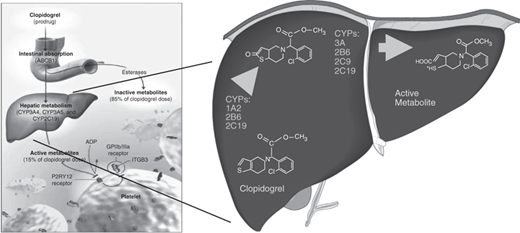Key Points
-
Drug summary:
-
Clopidogrel blocks the P2Y12 adenosine diphosphate (ADP) receptor on the surface of platelets and thus inhibits platelet activation.
-
Despite established clinical efficacy, an inadequate response to clopidogrel has been observed in up to 30% of compliant patients. Such variability has been labeled as “clopidogrel nonresponsiveness,” “clopidogrel hyporesponsiveness,” and “clopidogrel resistance.”
-
-
Pharmacogenomics:
-
Clopidogrel is a prodrug that is subject to extensive CYP450 metabolism.
-
The genes encoding the relevant metabolizing enzymes have known functional polymorphisms.
-
In particular, the CYP2C19*2 polymorphism is a loss-of-function variant that has been associated with lower levels of the active clopidogrel metabolite, diminished inhibition of ADP-induced platelet aggregation, and an increased risk of death and ischemic events in the setting of clopidogrel therapy and percutaneous coronary intervention.
-
Clopidogrel Therapy
As part of dual antiplatelet therapy (aspirin + ADP receptor blocker) for acute coronary syndrome (ACS), percutaneous coronary intervention (PCI), antithrombotic therapy for primary stroke prevention in atrial fibrillation patients who are indicated for but are not candidates for warfarin therapy.
As monotherapy for secondary prevention of stroke as an alternate to Aggrenox (dipyridamole + aspirin) and for management of mixed atherothrombosis (defined as recent ischemic stroke, recent myocardial infarction (MI), or symptomatic peripheral arterial disease).
Clopidogrel is an oral thienopyridine ingested as a prodrug and undergoes extensive metabolism (Fig. 7-1). Absorption of the prodrug can be influenced by the xenobiotic efflux pump P-gp (encoded by ABCB1). If the prodrug is absorbed, approximately 85% is inactivated via hydrolysis by esterases into a carboxylic acid metabolite. The remaining 15% requires biotransformation by the hepatic cytochrome 450 system into an active thiol metabolite. The active metabolite, formed within several hours, irreversibly binds the P2Y12 ADP receptor on the surface of platelets, leading to inhibition of ADP-dependent platelet activation and aggregation. Full antiplatelet effects occur within 4 to 6 hours and lasts for the lifetime of the platelet. Up to 30% of patients have a marginal degree of platelet inhibition in response to a standard 300 mg loading dose of clopidogrel.
Clopidogrel Pharmacogenomics
Polymorphism of genes involved in clopidogrel absorption, metabolism, and binding of active metabolites have been explored (see Fig. 7-1 for pathway; see Table 7-1 for notable genetic polymorphisms). However, association between polymorphism of CYP2C19 and clopidogrel response have been most consistently replicated and that CYP2C19 polymorphism was the only significant polymorphism noted in a genome-wide association studies (GWAS) investigating genetic influence of clopidogrel response.
| Candidate Gene (Chromosome Location) | Encodes for | Variant Studied [effect on protein] | Frequency of Risk Allele | Associated Disease Phenotype and Relative Risk |
|---|---|---|---|---|
| ABCB1 (7q21.1) | P-glycoprotein drug-efflux transporter, involved in intestinal absorption of clopidogrel |
C3435T (rs1045642) |
| |
| CYP3A4
(7q22.1) |
Eponymous protein involved in clopidogrel metabolism | IVS10+12G>A |
| |
| CYP3A5
(7q22.1) |
*3
(rs776746, G6986A) [nonfunctional] |
| ||
| CYP2C19
(10q24.1-q24.3) |
Eponymous protein essential in the two-step CYP450 hepatic metabolism of clopidogrel prodrug |
*2 (rs4244285, G681A) [aberrant splice site; nonfunctional] |
|
|
| *17 (rs12248560, C806T)
[enhanced-function allele] |
|
| ||
|
P2RY12 (3q24-q25) |
Receptor for active clopidogrel metabolite | T744C |
|
Stay updated, free articles. Join our Telegram channel

Full access? Get Clinical Tree



